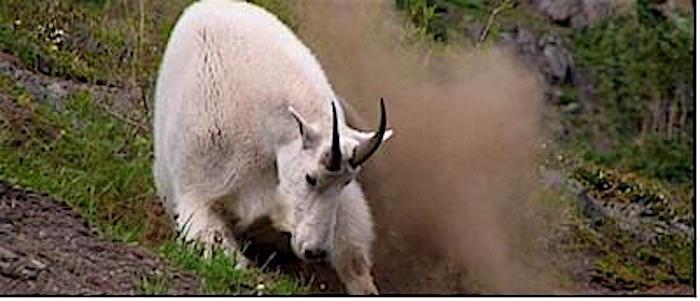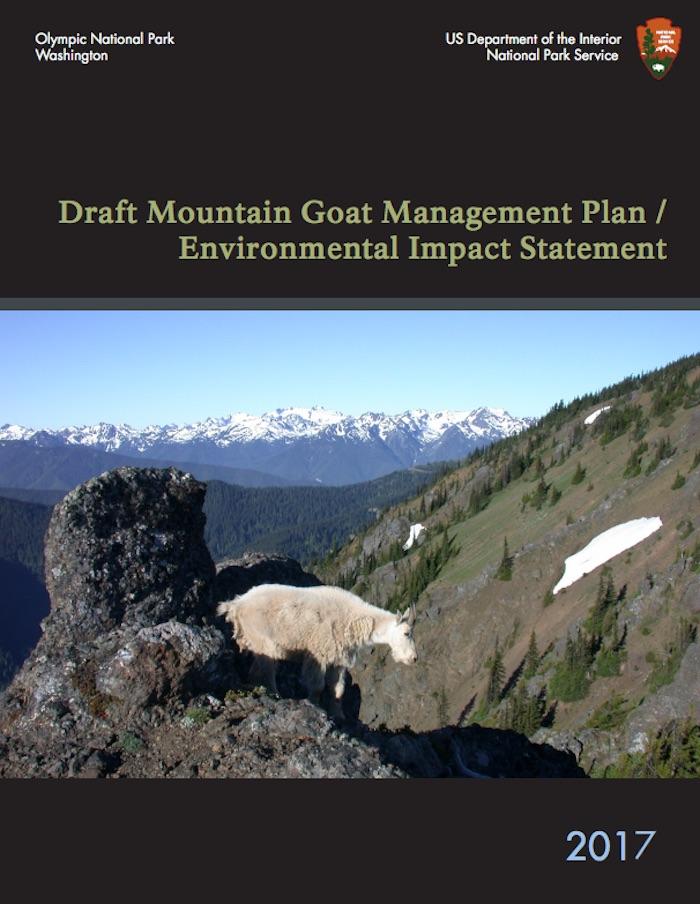A draft plan for dealing with nonnative mountain goats at Olympic National Park in Washington state, one that carries a preferred alternative calling for removal of as many goats as possible, is open for public comment through September 26.
The park's mountain goat population has grown past 600 animals and could increase by 45 percent over the next five years if current reproduction trends continue and no efforts are made to blunt the population, according to a report from the U.S. Geological Survey.
The population survey conducted last summer from the air confirmed that the mountain goat population in the park has been growing steadily for more than a decade and indicates that it has more than doubled over the past dozen years. Three successive surveys show that the population of mountain goats in the Olympic Mountains increased at an average rate of 8 percent annually from 2004 to 2016.
Park officials have been working in cooperation with the U.S. Forest Service and Washington Department of Fish and Wildlife to develop a management plan for the goats. Mountain goats were introduced to the Olympic Mountains in the 1920s, before establishment of Olympic National Park, and have since colonized the entire range, with most of the population residing within the park.
While the animals are considered picturesque to photographers and a symbol of wildness to others, they can be deadly. The family of 63-year-old Robert Boardman, of Port Angeles, Washington, filed a multimillion-dollar lawsuit against the Park Service over his death in Olympic in October 2010. He was protecting other hikers from a goat, estimated at 370 pounds, when it gored him in the thigh and then reportedly stood over him as he bled to death.
The family's lawsuit, seeking $10 million in damages, was dismissed when an appellate court ruled that the Park Service was immune to wrongful death filings.

National Park Service officials hope to remove most nonnative mountain goats from Olympic National Park/NPS
The preferred alternative listed in the draft environmental impact statement being prepared for the mountain goat management plan seeks to remove approximately 90 percent of the mountain goat population, or 625 to 675 mountain goats, through relocation and culling.
"It is anticipated that the success rate for capturing mountain goats would diminish over time and management would likely switch to almost exclusively lethal removal during year 3 or year 4 of the initial management," the statement's executive summary said. "By year 5, most mountain goats encountered would be lethally removed."
The plan’s purpose is to allow Olympic National Park to reduce or eliminate environmental impacts from nonnative mountain goats and reduce potential public safety issues associated with the goats’ presence in the park, a park release said.
“We are pleased and grateful for our close collaboration with the Forest Service and the Washington State Department of Fish and Wildlife in developing the draft plan,” said acting Olympic National Park Superintendent Lee Taylor. “Mountain goats are not native to the Olympic Peninsula and cause impacts to park resources and create safety risks for park visitors.”
The plan alternatives include actions proposed to occur within Olympic National Park and Olympic National Forest, and associated actions proposed by the Washington Department of Fish and Wildlife to translocate mountain goats to the Mount Baker-Snoqualmie and Okanogan-Wenatchee national forests in the Cascades.
Mountain goats are native to the North Cascades but exist in low numbers in many areas, the Park Service release said, adding that both the U.S. Forest Service and the Washington State Department of Fish and Wildlife have long been interested in restoring mountain goats to these depleted areas.
A series of public meetings are scheduled for mid-August:
August 14, Olympia
Olympic National Forest Supervisor’s Office
1835 Black Lake Blvd. SW
Olympia, WA 98512
360-956-2300
Time: 5-7 p.m.
August 15, Port Angeles
Olympic National Park Visitor Center
3002 Mount Angeles Road
Port Angeles, WA 98362
360-565-3004
Time: 6-8 p.m.
August 16, Everett
Everett Public Library Auditorium
2702 Hoyt Ave.
Everett, WA 98201
425-257-8000
Time: 5-7 p.m.
August 17, Seattle
Seattle Public Library
(Douglass-Truth Branch)
2300 Yesler Way
Seattle, WA 98122
260-684-4704
Time: 5-7 p.m.
There will be a short 15-minute presentation at 5:15 p.m. each evening, except 6:15 p.m. for the Port Angeles meeting, followed by an open house where staff will be present to answer questions.
This comment period also serves as the final designated comment period to provide specific written comments to be eligible to object to the U.S. Forest Service decisions on this project. The opportunity to comment ends 60 days following the date of the publication of the EPA Notice Of Availability in the Federal Register.
You can find the draft EIS and make comments on it at this site.
Copies of the draft EIS will also be available at public libraries in Darrington, Enumclaw, Granite Falls, North Bend, Sedro-Woolley, Skykomish, Sultan, Aberdeen, Amanda Park, Hoquiam, Hoodsport, Forks, Port Angeles and Port Townsend. Comments will also be accepted during scheduled public meetings or can be mailed or hand-delivered to: Superintendent, Olympic National Park, 600 East Park Avenue, Port Angeles, WA 98362. To ensure your comments are included in this process, they must be entered into the above referenced website or postmarked by September 26.
Comments will not be accepted by fax, email, or in any manner other than those listed above. Bulk comments in hard copy or electronic formats submitted on behalf of others will not be accepted.







Add comment